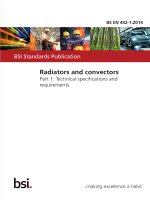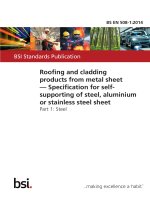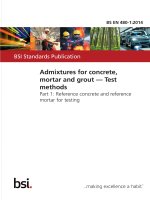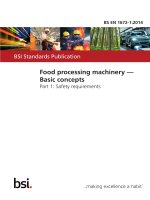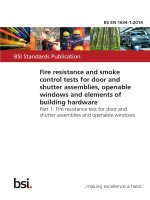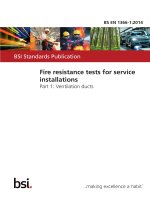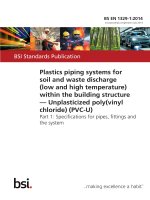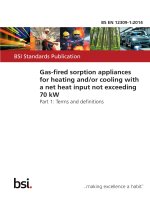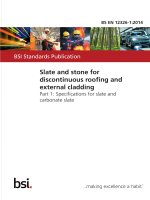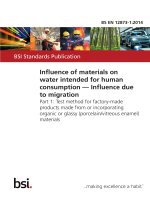Bsi bs en 62146 1 2014
Bạn đang xem bản rút gọn của tài liệu. Xem và tải ngay bản đầy đủ của tài liệu tại đây (1.36 MB, 40 trang )
BS EN 62146-1:2014
BSI Standards Publication
Grading capacitors for
high-voltage alternating
current circuit-breakers
Part 1: General
BRITISH STANDARD
BS EN 62146-1:2014
National foreword
This British Standard is the UK implementation of EN 62146-1:2014. It is
identical to IEC 62146-1:2013.
The UK participation in its preparation was entrusted to Technical
Committee PEL/33, Power capacitors.
A list of organizations represented on this committee can be obtained on
request to its secretary.
This publication does not purport to include all the necessary provisions of
a contract. Users are responsible for its correct application.
© The British Standards Institution 2014.
Published by BSI Standards Limited 2014
ISBN 978 0 580 72948 5
ICS 31.060.01; 31.060.70
Compliance with a British Standard cannot confer immunity from
legal obligations.
This British Standard was published under the authority of the
Standards Policy and Strategy Committee on 31 March 2014.
Amendments/corrigenda issued since publication
Date
Text affected
BS EN 62146-1:2014
EN 62146-1
EUROPEAN STANDARD
NORME EUROPÉENNE
EUROPÄISCHE NORM
March 2014
ICS 31.060.01; 31.060.70
English version
Grading capacitors for high-voltage alternating current circuit-breakers Part 1: General
(IEC 62146-1:2013)
Condensateurs de répartition pour
disjoncteurs à courant alternatif haute
tension Partie 1: Généralités
(CEI 62146-1:2013)
Spannungsausgleichskondensatoren für
Hochspannungs-WechselstromLeistungsschalter Teiln 1: Allgemeines
(IEC 62146-1:2013)
This European Standard was approved by CENELEC on 2013-10-30. CENELEC members are bound to comply
with the CEN/CENELEC Internal Regulations which stipulate the conditions for giving this European Standard
the status of a national standard without any alteration.
Up-to-date lists and bibliographical references concerning such national standards may be obtained on
application to the CEN-CENELEC Management Centre or to any CENELEC member.
This European Standard exists in three official versions (English, French, German). A version in any other
language made by translation under the responsibility of a CENELEC member into its own language and notified
to the CEN-CENELEC Management Centre has the same status as the official versions.
CENELEC members are the national electrotechnical committees of Austria, Belgium, Bulgaria, Croatia, Cyprus,
the Czech Republic, Denmark, Estonia, Finland, Former Yugoslav Republic of Macedonia, France, Germany,
Greece, Hungary, Iceland, Ireland, Italy, Latvia, Lithuania, Luxembourg, Malta, the Netherlands, Norway, Poland,
Portugal, Romania, Slovakia, Slovenia, Spain, Sweden, Switzerland, Turkey and the United Kingdom.
CENELEC
European Committee for Electrotechnical Standardization
Comité Européen de Normalisation Electrotechnique
Europäisches Komitee für Elektrotechnische Normung
CEN-CENELEC Management Centre: Avenue Marnix 17, B - 1000 Brussels
© 2014 CENELEC -
All rights of exploitation in any form and by any means reserved worldwide for CENELEC members.
Ref. No. EN 62146-1:2014 E
BS EN 62146-1:2014
EN 62146-1:2014
-2-
Foreword
The text of document 33/535/FDIS, future edition 1 of IEC 62146-1, prepared by IEC/TC 33, "Power
capacitors and their applications" was submitted to the IEC-CENELEC parallel vote and approved by
CENELEC as EN 62146-1:2014.
The following dates are fixed:
•
•
latest date by which the document has
to be implemented at national level by
publication of an identical national
standard or by endorsement
latest date by which the national
standards conflicting with the
document have to be withdrawn
(dop)
2014-09-14
(dow)
2016-10-30
Attention is drawn to the possibility that some of the elements of this document may be the subject of
patent rights. CENELEC [and/or CEN] shall not be held responsible for identifying any or all such patent
rights.
Endorsement notice
The text of the International Standard IEC 62146-1:2013 was approved by CENELEC as a European
Standard without any modification.
In the official version, for Bibliography, the following notes have to be added for the standards indicated:
IEC 60068-2-11
NOTE Harmonized as EN 60068-2-11
IEC 60068-2-42
NOTE Harmonized in EN 60068-2-42
BS EN 62146-1:2014
EN 62146-1:2014
-3-
Annex ZA
(normative)
Normative references to international publications
with their corresponding European publications
The following documents, in whole or in part, are normatively referenced in this document and are
indispensable for its application. For dated references, only the edition cited applies. For undated
references, the latest edition of the referenced document (including any amendments) applies.
NOTE When an international publication has been modified by common modifications, indicated by (mod), the relevant EN/HD
applies.
Publication
Year
Title
EN/HD
Year
CISPR 18-2
1986
Radio interference characteristics of overhead power lines and high-voltage equipment - Part
2: Methods of measurement and procedure
for determining limits
-
IEC Guide 109
Environmental aspects - Inclusion in
electrotechnical product standards
-
-
IEC 60050 (Series)
International Electrotechnical Vocabulary
(IEV)
-
-
IEC 60060-1
2010
High-voltage test techniques - Part 1: General EN 60060-1
definitions and test requirements
2010
IEC 60068-2-17
1994
Environmental testing - Part 2: Tests - Test Q: EN 60068-2-17
Sealing
1994
IEC 60071-1
2006
Insulation co-ordination - Part 1: Definitions,
principles and rules
EN 60071-1
2006
IEC 60270
+ corr. October
2000
2001
High-voltage test techniques - Partial
discharge measurements
EN 60270
2001
IEC 60376
2005
Specification of technical grade sulfur
hexafluoride (SF6) for use in electrical
equipment
EN 60376
2005
IEC 60507
1991
Artificial pollution tests on high-voltage
insulators to be used on a.c. systems
EN 60507
1993
IEC 60567
2011
Oil-filled electrical equipment - Sampling of
gases and analysis of free and dissolved
gases - Guidance
EN 60567
2011
IEC 60721-1
+ A1
+ A2
1990
1992
1995
Classification of environmental conditions Part 1: Environmental parameters and their
severities
EN 60721-1
1)
+ A2
1995
1995
Selection and dimensioning of high-voltage
insulators intended for use in polluted
conditions
-
-
IEC/TS 60815
(series)
IEC 61462
1)
2007
Composite hollow insulators - Pressurized andEN 61462
unpressurized insulators for use in electrical
equipment with rated voltage greater than 1
000 V - Definitions, test methods, acceptance
criteria and design recommendations
EN 60721-1 includes A1 to IEC 60721-1.
2007
BS EN 62146-1:2014
EN 62146-1:2014
-4-
IEC 62155 (mod)
2003
Hollow pressurized and unpressurized
ceramic and glass insulators for use in
electrical equipment with rated voltages
greater than 1 000 V
EN 62155
2003
IEC 62271-1
2007
High-voltage switchgear and controlgear Part 1: Common specifications
EN 62271-1
2008
IEC 62271-100
2008
High-voltage switchgear and controlgear EN 62271-100
Part 100: Alternating current circuit-breakers
IEC 62271-203
2003
High-voltage switchgear and controlgear Part 203: Gas-insulated metal-enclosed
switchgear for rated voltages above 52 kV
EN 62271-203
IEC/TR 62271-300
2006
High-voltage switchgear and controlgear Part 300: Seismic qualification of alternating
current circuit-breakers
-
2)
EN 62271-203 is superseded by EN 62271-203:2012, which is based on IEC 62271-203:2011.
2009
2)
2004
-
–2–
BS EN 62146-1:2014
62146-1 © IEC:2013
CONTENTS
1
Scope ............................................................................................................................... 6
2
Normative references ....................................................................................................... 6
3
Terms and definitions ....................................................................................................... 7
4
Abbreviations ................................................................................................................. 12
5
Normal and special service conditions ............................................................................ 13
5.1
5.2
6
General ................................................................................................................. 13
Normal service conditions ..................................................................................... 13
5.2.1 Ambient temperature ................................................................................. 13
5.2.2 Mechanical stress and vibrations ............................................................... 13
5.2.3 Additional service conditions for indoor and completely immersed
grading capacitor ....................................................................................... 13
5.3 Special service conditions ..................................................................................... 13
5.3.1 General ..................................................................................................... 13
5.3.2 Earthquakes .............................................................................................. 13
Ratings ........................................................................................................................... 14
7
6.1 Rated voltage (U cr ) ............................................................................................... 14
6.2 Rated insulation level ............................................................................................ 14
6.3 Rated frequency (f r ) .............................................................................................. 15
Design and construction ................................................................................................. 15
7.1
7.2
7.3
7.4
7.5
7.6
7.7
7.8
7.9
8
Capacitance tolerances ......................................................................................... 15
Capacitor loss requirements .................................................................................. 15
Angle of mounting ................................................................................................. 15
Minimum withstand value of mechanical bending load ........................................... 15
Requirements for impregnation medium in capacitor ............................................. 16
Protection against corrosion .................................................................................. 16
Nameplates ........................................................................................................... 16
Creepage distances for outdoor insulators ............................................................. 16
Tightness .............................................................................................................. 16
7.9.1 Liquid tightness ......................................................................................... 16
7.9.2 Gas tightness for grading capacitors immersed in gas ............................... 17
Type tests ...................................................................................................................... 17
8.1
8.2
8.3
8.4
8.5
8.6
8.7
Information for identification of specimens ............................................................. 17
Information to be included in type-test reports ....................................................... 17
Test conditions ...................................................................................................... 18
Dielectric tests ...................................................................................................... 18
8.4.1 General ..................................................................................................... 18
8.4.2 Capacitance measurement at power frequency .......................................... 19
8.4.3 Measurement of the tangent of the loss angle (tanδ) ................................. 20
8.4.4 Partial discharge test ................................................................................. 20
8.4.5 Switching impulse voltage test ................................................................... 21
8.4.6 Lightning and chopped impulse voltage test............................................... 21
8.4.7 Power frequency voltage test. .................................................................... 22
Voltage test at low and high temperature ............................................................... 22
Radio interference voltage (RIV) test ..................................................................... 23
Resonance frequency measurements .................................................................... 23
BS EN 62146-1:2014
62146-1 © IEC:2013
9
–3–
8.8 Mechanical bending test ........................................................................................ 23
8.9 Tightness test at different temperatures ................................................................ 23
8.10 Tightness test to check gas ingress from a pressurised environment ..................... 24
8.11 Vibration test ......................................................................................................... 24
Routine tests .................................................................................................................. 25
9.1
9.2
9.3
9.4
9.5
9.6
General ................................................................................................................. 25
Test conditions ...................................................................................................... 25
Capacitance and loss angle measurement at power frequency .............................. 25
Power frequency voltage test ................................................................................ 26
Partial discharge test ............................................................................................. 26
Tightness test ........................................................................................................ 26
9.6.1 General ..................................................................................................... 26
9.6.2 Oil impregnated capacitor .......................................................................... 26
9.6.3 Tightness test for gas filled grading capacitors .......................................... 26
9.7 Visual inspection and dimensional check ............................................................... 27
10 Recommendations for transport, storage, erection, operation and maintenance .............. 27
10.1
10.2
10.3
10.4
10.5
General ................................................................................................................. 27
Conditions during transport, storage and installation ............................................. 27
Installation............................................................................................................. 27
Unpacking and lifting ............................................................................................. 28
Assembly .............................................................................................................. 28
10.5.1 Mounting ................................................................................................... 28
10.5.2 Connections to metal parts ........................................................................ 28
10.5.3 Final installation inspection ........................................................................ 28
10.6 Operation .............................................................................................................. 28
10.7 Maintenance .......................................................................................................... 28
10.7.1 General ..................................................................................................... 28
10.7.2 Recommendation for the installation and maintenance .............................. 28
10.7.3 Recommendations for the user .................................................................. 29
10.7.4 Failure report ............................................................................................. 29
11 Safety ............................................................................................................................. 30
11.1 General ................................................................................................................. 30
11.2 Precautions by manufacturers ............................................................................... 30
11.3 Precautions by users ............................................................................................. 31
11.4 National regulations .............................................................................................. 31
12 Environmental aspects ................................................................................................... 31
Annex A (informative) Corrosion: Information regarding service conditions and
recommended test requirements ........................................................................................... 32
Annex B (informative) Resonance frequency measurements ................................................ 33
Bibliography .......................................................................................................................... 34
Figure 1 – Dielectric type tests .............................................................................................. 19
Figure 2 – Dielectric routine test ........................................................................................... 25
Figure B.1 – Example of resonance frequency measurement recording (see 8.7) .................. 33
Table 1 – Partial discharge test voltages and permissible levels ........................................... 21
BS EN 62146-1:2014
62146-1 © IEC:2013
–6–
GRADING CAPACITORS FOR HIGH-VOLTAGE
ALTERNATING CURRENT CIRCUIT-BREAKERS –
Part 1: General
1
Scope
This part of the IEC 62146 series is applicable to grading capacitors used on circuit-breakers.
Their function is to control the voltage distribution across the individual interrupter units of a
multi-break circuit-breaker.
Grading capacitors can also be used in parallel to the interrupter unit on single break circuitbreakers to modify the Transient Recovery Voltage (TRV).
The grading capacitor is a sub-component for the circuit-breaker and shall be specified in
accordance with the circuit-breaker specifications.
This standard applies to grading capacitors falling into one or both of the following categories
for:
–
mounting on air-insulated circuit-breakers;
–
mounting on enclosed circuit-breakers (for example immersed in SF 6 , in oil, etc.).
The testing for each of the above applications is in some cases different.
The object of this standard is:
–
to define uniform rules regarding performances, testing and rating;
–
to define specific safety rules;
–
to provide a guidance for installation and operation.
2
Normative references
The following documents, in whole or in part, are normatively referenced in this document and
are indispensable for its application. For dated references, only the edition cited applies. For
undated references, the latest edition of the referenced document (including any
amendments) applies.
IEC 60050
(all
parts),
International
)
electrotechnical
vocabulary
(available
at
IEC 60060-1:2010, High-voltage test techniques – Part 1: General definitions and test
requirements
IEC 60068-2-17:1994, Official version in Russian – Basic environmental testing procedures –
Part 2-17: Tests – Test Q: Sealing
IEC 60071-1:2006, Insulation co-ordination – Part 1: Definitions, principles and rules
IEC 60270:2000, High-voltage test techniques – Partial discharge measurements
BS EN 62146-1:2014
62146-1 © IEC:2013
–7–
IEC 60376:2005, Specification of technical grade sulfur hexafluoride (SF 6 ) for use in electrical
equipment
IEC 60507-1:1991, Artificial pollution tests on high-voltage insulators to be used on a.c.
systems
IEC 60567:2011, Oil-filled electrical equipment – Sampling of gases and analysis of free and
dissolved gases – Guidance
IEC 60721-1:2002, Classification of environmental conditions – Part 1: Environmental
parameters and their severities
IEC 60815 (all parts), Selection and dimensioning of high-voltage insulators intended for use
in polluted conditions
IEC 61462:2007, Composite hollow insulators – Pressurized and unpressurized insulators for
use in electrical equipment with rated voltage greater than 1 000 V – Definitions, test
methods, acceptance criteria and design recommendations
IEC 62155:2003, Hollow pressurized and unpressurized ceramic and glass insulators for use
in electrical equipment with rated voltages greater than 1 000 V
IEC 62271-1:2007, High-voltage switchgear and controlgear – Part 1: Common specifications
IEC 62271-100:2008, High-voltage switchgear and controlgear – Part 100: Alternating current
circuit-breakers
IEC 62271-203:2003, High-voltage switchgear and controlgear – Part 203: Gas-insulated
metal-enclosed switchgear for rated voltages above 52 kV
IEC 62271-300:2006, High-voltage switchgear and
qualification of alternating current circuit-breakers
controlgear
–
Part
300:
Seismic
IEC Guide 109, Environmental aspects – Inclusion in electrotechnical product standards
CISPR 18-2:1986, Radio interference characteristics of overhead power lines and highvoltage equipment – Part 2: Methods of measurement and procedure for determining limits
3
Terms and definitions
For the purposes of this document, the following terms and definitions apply.
3.1
arcing distance
shortest distance in the air external to the insulator between the metallic parts which normally
have the operating voltage between them
[SOURCE: IEC 60050-471:2007, 471-01-01]
3.2
capacitor element
device consisting essentially of two electrodes separated by a dielectric
[SOURCE: IEC 60050-436:1990, 436-01-03]
–8–
BS EN 62146-1:2014
62146-1 © IEC:2013
3.3
capacitor losses
active power dissipated in the capacitor
[SOURCE: IEC 60050-436:1990, 436-04-10]
3.4
capacitor terminals
terminals intended for electrical and mechanical connection to the terminals of the interrupter
units of circuit-breakers
3.5
capacitance tolerance
permissible difference between the actual capacitance and the rated capacitance under
specified conditions
Note 1 to entry: The actual capacitance should be measured at, or referred to, the temperature at which the rated
capacitance is defined.
[SOURCE: IEC 60050-436:1990, 436-04-01, modified by addition of Note to entry]
3.6
capacitor unit
assembly of one or more capacitor elements in the same container with terminals brought out
Note 1 to entry: A common type of unit for grading capacitors has a cylindrical housing of insulating material and
metal end flanges which serve as terminals.
[SOURCE: IEC 60050-436:1990, 436-01-04, modified by addition of Note to entry]
3.7
completely immersed capacitor
capacitor, both ends of which are intended to be immersed in insulating media other than
ambient air (e.g. oil or gas)
[SOURCE: IEC 60050-471:2007,
"bushing" instead of "capacitor")]
471-02-04, modified (definition
3.8
creepage distance
shortest distance along the surface of
parts
originally referred
to
a solid insulating material between two conductive
Note 1 to entry: The surface of cement or any other non-insulating jointing material is not considered as forming
part of the creepage distance.
Note 2 to entry: If high-resistance coating is applied to parts of the insulating part of an insulator, such parts are
considered to be effective insulating surface and the distance over them is included in the creepage distance.
[SOURCE: IEC 60050-604:1987, 604-03-61, modified by addition of Notes to entry]
3.9
dielectric of a capacitor
insulating material between the electrodes of the capacitor element
Note 1 to entry: The major insulation generally consists of paper, plastic film, or a mixed of paper and plastic film
subsequently treated and impregnated with oil or gas at atmospheric pressure or higher.
BS EN 62146-1:2014
62146-1 © IEC:2013
–9–
3.10
external insulation
distance in air and the surfaces in contact with open air of insulation of the grading capacitor
which are subject to dielectric stresses
Note 1 to entry: They are also subject to to the effects of the atmospheric and other external conditions such as
pollution, humidity, ice, vermin, etc.
3.11
failure
termination of the ability of an item to perform a required function
Note 1 to entry:
After failure the item has a fault.
Note 2 to entry:
"Failure" is an event, as distinguished from "fault", which is a state.
Note 3 to entry:
This concept as defined does not apply to items consisting of software only.
[SOURCE: IEC 60050-191:1990, 191-04-01]
3.12
flashover
electric breakdown between conductors in a gas or in a liquid or in a vacuum, at least partly
along the surface of solid insulation
[SOURCE: IEC 60050-212:2012, 212-11-47]
3.13
grading capacitor
capacitor for installation on high-voltage circuit-breakers to control the voltage distribution
across the individual interrupter unit
Note 1 to entry:
The grading capacitors alone are accessories of the circuit-breaker
3.14
indoor capacitor
capacitor, both ends of which are intended to be in ambient air at atmospheric pressure but
not exposed to outdoor atmospheric conditions
[SOURCE: IEC 60050-471:2007,
"bushing" instead of "capacitor")]
471-02-05, modified (definition
originally referred
to
3.15
insulating envelope
insulator which is open from end to end, with or without sheds, including end fittings
Note 1 to entry
elements.
An insulating envelope can be made from one or more permanently assembled insulating
Note 2 to entry: The insulating envelope may be in ceramic, glass or analogous inorganic material, cast or
moulded resin, composite insulating material, in one piece or more pieces permanently assembled.
[SOURCE: IEC 60050-471:2007, 471-01-08, modified (definition originally referred to a hollow
insulator and Note 2 to entry has been added)]
3.16
outdoor capacitor
capacitor, both ends of which are intended to be in ambient air at atmospheric pressure, and
exposed to outdoor atmospheric conditions
BS EN 62146-1:2014
62146-1 © IEC:2013
– 10 –
[SOURCE: IEC 60050-471:2007,
"bushing" instead of "capacitor")]
471-02-07, modified (definition
originally referred
to
3.17
internal insulation
internal solid, liquid or gaseous parts of the insulation of the grading capacitor which are
protected from the effects of atmospheric conditions
Note 1 to entry: The parts are also protected from other external conditions such as pollution, humidity, ice, vermin,
etc.
3.18
major failure (of a grading capacitor)
failure of a grading capacitor which causes the cessation of its fundamental function.
Note 1 to entry: A major failure will result in a mandatory removal from service within 30 min for unscheduled
maintenance.
3.19
mechanical stress
any mechanical stress applied to the insulating envelope and to the terminals of the grading
capacitor
Note 1 to entry:
It is a function of the following main forces:
–
forces on the terminals due to the circuit-breaker connection;
–
forces due to the wind and ice;
–
seismic forces;
–
forces due to the operating conditions, opening and closing, of the circuit- breaker;
–
thermal forces due to the ambient medium conditions;
–
forces due to the transportation of the circuit-breaker or grading capacitors.
3.20
minor failure (of a grading capacitor)
any failure of a grading capacitor which does not cause a major failure of the grading
capacitor
3.21
puncture
disruptive discharge occurring through a solid insulation material, producing a path of
permanent damage
Note 1 to entry: The term puncture is also used as a synonym for electrical breakdown in solids.
[SOURCE: IEC 60050-212:2010, 212-11-49]
3.22
rated capacitance of a capacitor
Cr
capacitance value for which the capacitor has been designed
3.23
rated chopped lightning impulse withstand voltage
required peak value of the chopped lightning impulse withstand voltage which characterises
the insulation of a grading capacitor as regards the withstand tests
Note 1 to entry:
IEC 60060-1.
The definitions and the standard parameters applicable to chopped impulses are specified in
BS EN 62146-1:2014
62146-1 © IEC:2013
– 11 –
3.24
rated frequency of a capacitor
fr
frequency for which the capacitor has been designed
[SOURCE: IEC 60050-436:1990, 436-01-14, modified by addition of symbol]
3.25
rated insulation level
test voltages, under specified conditions, that the insulation is designed to withstand
Note 1 to entry: These test voltages can be for instance:
a)
rated chopped and lightning impulse and short duration power frequency withstand voltages for capacitors
installed on circuit-breaker with rated voltage lower than 300 kV.
b)
rated switching, lightning, chopped impulse and short duration power frequency withstand voltages for
capacitors installed on circuit-breaker with rated voltage equal to or greater than 300 kV.
Note 2 to entry: The rated insulation levels of the grading capacitor should be equal to or higher than the relevant
requirements for the circuit-breaker interrupting unit.
[SOURCE: IEC 60050-421:1990, 421-09-02, modified Note to entry]
3.26
rated lightning impulse withstand voltage
required peak value of the lightning impulse withstand voltage which characterises the
insulation of an equipment as regards the withstand tests
Note 1 to entry: The standard lightning impulse has a front time of 1,2 µs and a time-to-half-value of 50 µs as
specified in IEC 60060-1.
3.27
rated short duration power frequency withstand voltage
required r.m.s. value of sinusoidal power frequency voltage that the equipment withstands
during tests made under specified conditions and for a duration of 1 min unless otherwise
specified
3.28
rated switching impulse withstand voltage
required peak value of the switching impulse withstand voltage which characterises the
insulation of an equipment as regards the withstand tests
Note 1 to entry: The standard switching impulse has a time-to-crest of 250 µs and a time-to-half-value of 2500 µs
as specified in IEC 60060-1.
3.29
rated temperature category of a capacitor
range of temperature of the ambient air or other medium in which the capacitor is immersed
during the service life and for which it has been designed
3.30
rated voltage of a capacitor
U cr
r.m.s. value of the alternating voltage assigned to the capacitor for identification and at which
the capacitor is designed to operate continuously
3.31
rated voltage of circuit-breaker
Ur
indicates the upper limit of the highest voltage of systems for which the circuit-breaker is
intended
– 12 –
BS EN 62146-1:2014
62146-1 © IEC:2013
Note 1 to entry: See IEC 62271-1.
Note 2 to entry:
U r used in IEC 62271 series corresponds to U m presented in IEC 60071.
3.32
resonance frequency
frequency for which the reactance of the intrinsic capacitance of the capacitor is equal to the
reactance of the self-inductance of the capacitor
3.33
sample
device for testing
Note 1 to entry: Examples of such devices are a complete small capacitor, or the housing of a grading capacitor
with metal end flanges filled with impregnating fluid.
3.34
tangent of the loss angle of a capacitor
tan δ
ratio between the equivalent series resistance and the capacitive reactance of a capacitor at
specified sinusoidal alternating voltage and frequency
[SOURCE: IEC 60050-436:1990, 436-04-11]
3.35
voltage grading factor of a circuit-breaker
(F VG )
value that defines the standard values of rated voltages for the grading capacitor.
Note 1 to entry: This factor is the ratio between the actual maximum power frequency voltage fraction across one
interrupter unit of a multi-break circuit-breaker and the calculated linear power frequency voltage distribution per
interrupting unit.
Note 2 to entry: It is dependent on the circuit-breaker design, of the capacitance value of the grading capacitor and
its tolerance and of the safety margin.
4
Abbreviations
TRV
Transient Recovery Voltage
Cr
Rated capacitance of a capacitor
fr
Rated frequency of a capacitor
U cr
Rated voltage of a capacitor
Ur
Rated voltage of circuit-breaker
tan δ
Tangent of the loss angle of a capacitor
F VG
Voltage grading factor of a circuit-breaker
U CPF
Short-duration power frequency withstand voltage for the grading capacitor
U PF
Short-duration power frequency withstand voltage across the open circuit-breaker
U CLIW L
Rated lightning impulse withstand voltage for the grading capacitor
U (LIW L
Combined lightning and frequency withstand voltage for the circuit-breaker
+ PF)
U CSIW L
U (SIW L
Rated switching impulse withstand voltage for the grading capacitor
+ PF)
Combined switching and frequency withstand voltage for the circuit-breaker
U CCHOPPED
Chopped lightning impulse voltage for the grading capacitor
BIL
Bushings insulated level
SIL
Standard insulation level
RIV
Radio interference voltage
BS EN 62146-1:2014
62146-1 © IEC:2013
5
– 13 –
Normal and special service conditions
5.1
General
The grading capacitors are intended to be installed on circuit-breakers, for which the normal
and special service conditions are described in IEC 62271-1.
Additional service conditions specific to the capacitors are given in 5.2.3.
5.2
Normal service conditions
5.2.1
Ambient temperature
For outdoor application the normal service conditions of the grading capacitor are given in
IEC 62271-1.
For an immersed capacitor, the temperature around the capacitor can be higher than the
ambient air around the breaker. The preferred values of maximum surrounding temperature to
be specified should be: 60 °C, 70 °C, 80 °C.
The internal operating temperature of the capacitor is higher than the maximum temperature
around the capacitor and should be considered by the capacitor manufacturer.
5.2.2
Mechanical stress and vibrations
Mechanical stress and vibrations due to:
–
forces due to wind and ice are according to IEC 62271-1;
–
forces on the terminals due to the circuit-breaker connection which value shall be defined
by agreement between purchaser and capacitor manufacturer;
–
forces due to the operations consequent to vibrations, such as opening and closing, of the
circuit-breaker.
Vibrations due to earthquakes are not considered for normal service conditions.
5.2.3
Additional service conditions for indoor and completely immersed grading
capacitor
The completely immersed grading capacitors are subjected to the following other conditions:
–
–
the influence of SF 6 pressure;
the resistance of the capacitor materials against the decomposition products of SF 6 .
5.3
5.3.1
Special service conditions
General
The special service conditions are given in IEC 62271-1; if they are required, the purchaser
will specify it to the capacitor manufacturer.
5.3.2
Earthquakes
For the earthquake stress the grading capacitors have to be considered as accessories of the
circuit-breaker and in this way they have to satisfy the seismic qualification rules according to
IEC 62271-300.
NOTE Assuming that the mechanical stresses on circuit-breakers due to seismic activity are covered by the
relevant standards, the stressing of the grading capacitor is low in comparison to transport or operation stressing.
BS EN 62146-1:2014
62146-1 © IEC:2013
– 14 –
6
Ratings
6.1
Rated voltage (U cr )
The rated voltage U cr of a grading capacitor is based on the following equation:
U cr =
U r × FVG
n× 3
where
Ur
is the rated voltage of the circuit-breaker;
n
is the number of interrupter units per pole;
F VG
is the voltage grading factor, standardized to 1,2.
NOTE 1 This value is 20 % higher than the linear voltage distribution and covers most of the common
applications.
NOTE 2 In case of single break circuit-breaker the grading factor is not applicable, In some cases, a higher
voltage grading factor may be necessary (for example due to low capacitance of grading capacitor and/or high
stray capacitance of the circuit-breaker and/or more than 2 interrupter units).
6.2
Rated insulation level
The insulation level and the test voltage value shall be obtained by the criteria defined in the
type and routine test clauses.
Guidance for the choice of the insulation level is given:
–
in IEC 62271-1 for the grading capacitor of an air insulated circuit-breaker;
–
in IEC 62271-1 for the grading capacitor of an immersed capacitor in a dead tank breaker;
–
in IEC 62271-203 for the grading capacitor of an immersed capacitor in a gas insulated
switchgear.
The grading factor F GV has to be calculated for the circuit-breaker depending on its design.
The voltage stress for the capacitor shall be calculated with the following equation using the
test voltage across the complete open circuit-breaker (see IEC 62271-1):
U CPF =
U CLIWL =
U CSIWL =
U PF × FVG
n
U (LIWL + PF) × FVG
n
U (SIWL + PF) × FVG
n
U CCHOPPED = 1,15 × U CLIWL
where
U CPF
is the short-duration power frequency withstand voltage for the grading
capacitor;
U PF
is the short-duration power frequency withstand voltage across the open
circuit-breaker;
BS EN 62146-1:2014
62146-1 © IEC:2013
– 15 –
U CLIWL
is the rated lightning impulse withstand voltage for the grading capacitor;
U (LIWL + PF)
is the combined lightning and frequency withstand voltage for the circuitbreaker;
U CSIWL
is the rated switching impulse withstand voltage for the grading capacitor;
U (SIWL + PF)
is the combined switching and frequency withstand voltage for the circuitbreaker
U CCHOPPED
is the chopped lightning impulse voltage for the grading capacitor.
The test value shall be the next higher voltage out of the list given below.
The following r.m.s values, according to IEC 60071-1, expressed in kV are standardised as
short-duration power frequency withstand voltages:
115 – 140 – 185 – 230 – 275 – 325 – 360 – 395 – 460 – 510 – 570 – 630 – 680 – 710 – 790
The following peak values, according to IEC 60071-1, expressed in kV are standardised as
rated lightning and switching impulse withstand voltages:
200 – 250 – 325 – 380 – 450 – 550 – 650 – 750 – 850 – 950 – 1 050 – 1 175 – 1 300 – 1 425
1 550 – 1 675 – 1 800 – 1 950 – 2 100 – 2 250 – 2 400
Rated frequency (f r )
6.3
Standard values are 50 and 60 Hz.
7
Design and construction
7.1
Capacitance tolerances
The measured capacitance shall not differ from the rated capacitance by more than ±5 % for
capacitors for air insulated circuit-breakers and ±3 % for capacitor in enclosed circuitbreakers.
7.2
Capacitor loss requirements
The capacitor loss is usually expressed in term of tanδ.
NOTE 1
The capacitor loss is sometimes expressed as power factor (sinδ)
The requirements relating to capacitor losses at rated frequency should be agreed upon
between capacitor manufacturer and purchaser.
NOTE 2
The purpose of the measurement of the losses is to check the uniformity of the production.
NOTE 3 The tanδ value is dependent on the insulation design and the voltage, the temperature and the measuring
frequency.
7.3
Angle of mounting
The capacitors shall be designed to be installed in any direction: vertical, horizontal or
oblique.
7.4
Minimum withstand value of mechanical bending load
The test bending moment M C shall be calculated as follows:
– 16 –
BS EN 62146-1:2014
62146-1 © IEC:2013
where
MC
is in Nm;
l
is the length of the capacitor in m;
m
is the weight of the capacitor in kg;
g
is the gravitational acceleration 9,81 m/s .
2
NOTE
The factor of 0,7 has been taken from IEC 62155:2003, 8.3.1.
M C shall have a minimum value of 2 500 Nm.
7.5
Requirements for impregnation medium in capacitor
The capacitor manufacturer shall specify the type of the impregnation medium (liquid or gas)
used in the capacitor.
7.6
Protection against corrosion
Protection against corrosion shall be ensured by the use of suitable materials or by the
application of suitable protective coatings to the exposed surfaces, taking into account the
intended conditions of use in accordance with the service conditions stated in Clause 5
(reference is made to Annex A).
7.7
Nameplates
The capacitor shall be provided with nameplates which contain the following information:
–
name or mark of the capacitor manufacturer;
–
year of manufacture;
–
capacitor manufacturer's type designation;
–
serial number or equivalent;
–
–
rated voltage of capacitor U cr ;
rated frequency of capacitor;
–
rated capacitance C r and its tolerances;
–
–
power frequency test voltage U CPF ;
temperature range;
–
quantity of oil or rated gas filling pressure;
–
oil or gas designation;
–
reference to IEC 62146-1.
7.8
Creepage distances for outdoor insulators
IEC 60815 gives general rules that assist in choosing insulators which should give
satisfactory performance under polluted conditions.
7.9
7.9.1
Tightness
Liquid tightness
A grading capacitor is defined as a sealed pressure system (see 5.15.3 of IEC 62271-1:
2007). This means that no liquid loss shall be detected during it specified lifetime.
BS EN 62146-1:2014
62146-1 © IEC:2013
7.9.2
– 17 –
Gas tightness for grading capacitors immersed in gas
Immersing in its most severe ambient conditions (maximum gas-pressure and -temperature),
the maximum gas (for example SF 6 ) content of the oil shall not exceed a level corresponding
to a leakage rate of 10 -6 cm 3 /s at 100 kPa for 1 dm 3 oil.
8
8.1
Type tests
Information for identification of specimens
The manufacturer shall submit to the testing laboratory, drawings and other data containing
sufficient information to unambiguously identify by type the essential details and parts of the
capacitor presented for test, containing at least the following information:
•
capacitance value with tolerance
•
tanδ max permissible value at specified voltage
•
•
rated voltage U cr
temperature range
•
rated insulation level (power frequency, BIL/SIL)
•
partial discharge permissible value at specified voltage
•
weight
•
quantity of oil
•
capacitance change in case of one capacitive element breakdown (short-circuit)
After completion of verification, the reference of the drawing/data shall be retained by the test
laboratory. The detail drawings and other data should be returned to the manufacturer. The
manufacturer shall maintain detailed design records of all component parts of the switchgear
and controlgear tested and shall ensure that these may be identified from information included
in the drawings and data schedules. The testing laboratory shall check that drawings and data
schedules adequately represent the essential details and parts of the capacitor to be tested
but shall not be responsible for the accuracy of the detailed information. The test specimen
shall be clearly identified in the test report to guarantee the traceability (serial number, part
number, product family, type number, reference to manufacturing reference).
NOTE An individual type test need not be repeated for a change of construction detail, if the manufacturer can
demonstrate that this change does not influence the result of that individual type test.
8.2
Information to be included in type-test reports
The results of all type-tests shall be recorded in type-test reports containing sufficient data to
prove compliance with the ratings and the test clauses of the relevant standards. Sufficient
information shall be included so that the essential parts of the capacitor can be identified. In
particular, the following information shall be included:
–
manufacturer;
–
type designation and serial number of capacitor tested;
–
rated characteristics of capacitor tested as specified in the relevant IEC standard;
–
general description (by manufacturer) of capacitor tested;
–
photographs to illustrate the condition of capacitor before and after test;
–
sufficient outline drawings and data schedules to represent the capacitor tested;
–
reference numbers of all drawings including revision number submitted to identify the
essential parts of the capacitor tested;
–
IEC standard 62146-1 with year of publication;
–
details of the testing arrangements (including diagram of test circuit);
– 18 –
BS EN 62146-1:2014
62146-1 © IEC:2013
–
statements of the behaviour of the capacitor during tests, its condition after tests and any
parts renewed or reconditioned during the tests;
–
records of the test quantities during each test or test duty, as specified in the relevant IEC
standard.
8.3
Test conditions
The order or possible combination of the type tests is at the discretion of the capacitor
manufacturer, except the dielectric type test which has to be done according to Figure 1 .
The type tests can be carried out on different units; electrical type tests (Figure 1) have to be
made on the same unit. The number of samples is one for each test.
Unless otherwise specified for a particular test or measurement, the temperature of the
capacitor dielectric at the start of the test shall be between +5 °C and +35 °C and shall be
known.
It may be assumed that the temperature of the dielectric is the same as that of the ambient
air, provided that the capacitor has been left in an unenergized state in a constant ambient-air
temperature for an adequate period.
If correction is necessary, the reference temperature shall be +20 °C, unless otherwise
agreed between the manufacturer and the purchaser.
Unless otherwise specified the a.c. tests and measurements shall be carried out at a
frequency between 0,8 and 1,2 times the rated frequency for capacitors with a rated
frequency of 50 Hz or higher and at a frequency between 40 Hz and 72 Hz for capacitors with
a rated frequency below 50 Hz.
8.4
8.4.1
Dielectric tests
General
The objective of the dielectric tests is to test the withstand of the internal part of the capacitor.
It is assumed that the wet tests are performed with the grading capacitor mounted on the
circuit-breaker as part of the circuit-breaker type tests. For that reason, the wet tests can be
omitted for the grading capacitor alone.
BS EN 62146-1:2014
62146-1 © IEC:2013
– 19 –
Dielectric type test
C and tan δ measurement
See 8.4.2 and 8.4.3
Partial discharge
measurement
See 8.4.4
Switching impulse
(if required)
See 8.4.5
Lightning impulse
and chopped impulse
See 8.4.6
Power frequency
withstand test
See 8.4.7
Partial discharge
measurement
See 8.4.4
C and tan δ measurement
See 8.4.2 and 8.4.3
End of dielectric
type test
IEC 2404/13
Figure 1 – Dielectric type tests
8.4.2
Capacitance measurement at power frequency
The capacitance shall be measured using a method that excludes errors due to harmonics
and to accessories in the measuring circuit.
The accuracy of the measuring method shall be given.
The final capacitance measurement shall be carried out at a voltage between 1 and at
1,2 times the voltage U cr after the voltage tests (see 8.4.7).
The acceptance criteria is that the change of capacitance before and after the test shall not
be higher than the value “Capacitance change in case of one capacitive element breakdown
(see Note 1)” specified on the data sheet of the capacitor.
NOTE 1
The capacitance change is the following according to the formula:
n
∆C < C ×
− 1
n −1
– 20 –
BS EN 62146-1:2014
62146-1 © IEC:2013
where
C is the 1 st measured value
n is the number of elements in series in the capacitor.
NOTE 2 If the dielectric system of the capacitor is such that the measured capacitance varies with the voltage, it
is more meaningful to repeat the capacitance measurement after the voltage test at the same voltage as that
previously used and then at the rated voltage.
NOTE 3 If the number of elements in series in the tested unit is large, it may be difficult to ascertain that no
puncture has occurred because of the following uncertainties:
–
reproducibility of the measurement;
–
capacitance change caused by the mechanical forces on the elements during the voltage tests;
–
capacitance change caused by temperature difference of the capacitor before and after the tests. In this case,
it should be proven by the capacitor manufacturer that no puncture had occurred. This can be done by, for
example, comparing the capacitance variations of capacitors of the same type and/or by calculation of the
capacitance change caused by the temperature increase during the test. In view of the uncertainty in the case
where measurements are made on a stack, it may be preferable to carry out these measurements on each unit
separately.
NOTE 3 Measurement of the capacitance may be made at a frequency outside the rated frequency range,
provided an appropriate correction factor is agreed.
8.4.3
Measurement of the tangent of the loss angle (tanδ)
The capacitor losses (tanδ) shall be measured at a voltage between 1 and 1,2 times the
voltage U cr after the voltage tests, using a method that excludes errors due to harmonics and
to accessories in the measuring circuit. The measured value before and after the type test
shall not be higher than the maximum value specified on the data sheet of the capacitor.
The accuracy of the measuring method shall be given.
NOTE 1 Since the tanδ value of certain types of dielectric is a function of the energisation time before the
measurement, (see [1] 1), the tanδ measurement at 10 kV will not give repeatable values.
NOTE 2 Measurement of the losses may be made at a frequency outside the rated frequency range, provided an
appropriate correction factor is agreed upon.
8.4.4
Partial discharge test
After a pre-stressing performed according to procedure A or B, the partial discharge test
voltage specified in Table 1 is applied and the corresponding partial discharge level shall be
measured within 30 s.
The limits of partial discharge level are specified in Table 1.
Procedure A: The partial discharge test voltages are reached while decreasing the voltage
after the power frequency withstand test (8.4.7), which covers the pre-stress voltage.
Procedure B: The partial discharge test is performed after the a.c. voltage withstand test. The
applied voltage is raised to 80 % of the withstand voltage, maintained for not less than 60 s,
then reduced without interruption to the specified partial discharge test voltage.
The preferred method is the procedure A; in case of limitation of the laboratory the procedure
B can be applied. The test method used shall be indicated in the test report. The test circuit
for the measurement of partial discharges shall be in accordance with 4.2 of IEC 60270:2000.
—————————
1 Numbers in square brackets refer to the Bibliography.
BS EN 62146-1:2014
62146-1 © IEC:2013
– 21 –
Table 1 – Partial discharge test voltages and permissible levels
Pre-stress voltage
Measuring voltage
Permissible partial
discharge level
Apparent charge
Air insulated capacitor
Immersed capacitors
80 % U CPF a.c. short-duration
power-frequency test
1,5 × U cr
≤ 5 pC
1,5 × U cr
≤ 3 pC
NOTE For capacitors having very large rated capacitance, a partial discharge test with the values specified
above may be impossible to carry out because of the poor transmission factor and the power limitation of the test
transformer. In such cases, the relevant values will be agreed upon between capacitor manufacturer and
purchaser.
8.4.5
Switching impulse voltage test
The test shall be performed on all grading capacitors for installation on circuit-breaker having
a rated voltage U r ≥ 300 kV.
Fifteen switching impulses of each polarity, with a peak value U SIWL according to 6.2, shall be
applied between the terminals.
The waveform of the applied impulses shall be the standard wave 250/2 500 µs in accordance
with IEC 60060-1.
It is permissible, after changing polarity, to apply some impulses of reduced amplitude before
the application of the test impulses.
The capacitor has passed the test if:
–
not more than two external flashovers occur on either polarity,
–
no internal breakdown has occurred, which shall be verified by means of records of the
impulse voltage wave and by a measurement of the capacitance, tanδ and partial
discharges of the units at the rated voltage before and after the test (see 8.4.2, 8.4.3 and
8.4.4).
Voltage records shall be made of each impulse.
NOTE1 Mounting of the capacitor on a metal pedestal influences the switching impulse withstand characteristics.
It is therefore acceptable to perform the test with a pedestal mounting corresponding to the service conditions.
Direct positioning on an earthed floor is the most severe case.
NOTE 2 The arrangement of the line connection can influence the flashover characteristics. It may therefore be
necessary to perform the type test with a line connection corresponding to service conditions at the option of the
capacitor manufacturer.
8.4.6
Lightning and chopped impulse voltage test
The test is applicable to all types of capacitors.
The capacitor shall be subjected successively to:
–
15 lightning impulses of positive polarity; followed by
–
1 lightning impulse of negative polarity; followed by
–
3 chopped lightning impulses of negative polarity; and by
–
14 lightning impulses of negative polarity.
The lightning impulses (U CLIWL , U CCHOPPED ) with a peak value according to 6.2, shall be
applied between the terminals.
– 22 –
BS EN 62146-1:2014
62146-1 © IEC:2013
The waveform of the applied impulses shall be the standard wave 1,2/50 µs in accordance
with IEC 60060-1.
The chopped impulse shall be a standard lightning impulse, and the time to sparkover on the
chopping device shall be between 2 µs and 3 µs.
No damping resistor is allowed during this test, the chopping circuit shall be as small as
possible to limit the natural damping of the overswing in the opposite polarity so as to be as
close as possible to normal service conditions. For an immersed grading capacitor, the
chopping gap has to be mounted in parallel to the capacitor in its immersed environment.
It is permissible, after changing polarity, to apply some impulses of reduced amplitude before
the application of the test impulses.
For the outdoor capacitors the chopping could be in air, for the immersed capacitors the
chopping shall be in the immersing gas/liquid or in another equivalent gas/liquid.
The capacitor has passed the test if:
–
not more than two external flashovers occur on either polarity,
–
no internal breakdown has occurred, which shall be verified by means of records of the
impulse voltage wave and by a measurement of the capacitance, tanδ and partial
discharges of the units at the rated voltage before and after the test (see 8.4.2, 8.4.3 and
8.4.4).
Voltage records shall be made of each impulse.
8.4.7
Power frequency voltage test.
The test shall be performed on all grading capacitors. The value of the voltage U PF shall be
according to 6.2.
The power frequency voltage withstand test shall be carried out in accordance with
IEC 60060-1. The voltage shall be maintained for 1 min.
The capacitor has passed the test if:
–
no flashover occurs external to the grading capacitor,
–
no internal breakdown occurs, which shall be verified by a measurement of the
capacitance, tanδ and partial discharges of the units at the rated voltage before and after
the test (see 8.4.2, 8.4.3 and 8.4.4).
The dielectric test is passed if each acceptance criteria for each test (8.4.2 to 8.4.7) are
covered.
8.5
Voltage test at low and high temperature
The test can be carried out on a sample or a full size capacitor. The routine tests shall be
carried out before the test.
An a.c. voltage of 2U cr shall be applied for 2 h between the terminals of the capacitors
maintained at a temperature equal to the minimum value specified for the capacitor.
An a.c. voltage of 2U cr shall be applied for 2 h between the terminals in an atmosphere lightly
ventilated and with a temperature of air approximately equal to the maximum value specified
for the capacitor.
